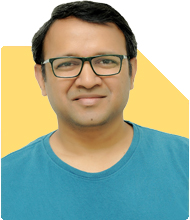Retirement At 50? - 36 Year Old With 1 Crore Investments, No House, Seeks Advice
Ramalingam Kalirajan |10894 Answers |Ask -Follow
Mutual Funds, Financial Planning Expert - Answered on Feb 07, 2025
He has an MBA in finance from the University of Madras and is a certified financial planner.
He is the director and chief financial planner at Holistic Investment, a Chennai-based firm that offers financial planning and wealth management advice.... more

I am 36 and my wife is 33, both of us have a monthly SIP of 1.25L. Our corpus in MF has just crossed 1Cr, we have gold worth 40L and other cash reserves worth 5-6L for emergency. This is the wealth built by both of us, family money is not included which is considerable in real estate. We have one son, 6Y and plan to retire by 50. We'd have an estimated monthly expense of 2L-3L per month since we don't own a house so far and plan to stay for rent till I retire. Just need to know if I am on the right path? Should we diversify the investment portfolio? We like to live very comfortably and don't like to think before making an expense or plan for it financially.
Current Financial Overview
Mutual Fund Corpus: Rs. 1 crore
Monthly SIP: Rs. 1.25 lakh (combined)
Gold Holdings: Rs. 40 lakh
Emergency Cash Reserves: Rs. 5-6 lakh
Real Estate: Considerable family wealth (not included in investment planning)
Planned Retirement Age: 50 years
Monthly Expense Expectation: Rs. 2-3 lakh
Housing Plan: Staying on rent until retirement
Strengths in Your Current Plan
Consistent Investing: Your monthly SIP ensures disciplined wealth accumulation.
Diverse Asset Allocation: Equity, gold, and cash reserves balance risk and liquidity.
Strong Emergency Fund: Ensures short-term financial stability.
Flexibility in Housing: Staying on rent provides location freedom and liquidity.
Areas for Improvement
Portfolio Diversification: High reliance on mutual funds and gold.
Retirement Corpus Planning: Ensuring Rs. 2-3 lakh per month after 50 requires a detailed strategy.
Child’s Education Fund: Higher education costs need structured investments.
Tax Efficiency: Optimising taxation on investments can enhance post-tax returns.
Optimising Investment Portfolio
Balancing Equity and Debt: Actively managed funds ensure better growth than index funds.
Reducing Gold Exposure: Gold is a hedge, not a wealth-building asset.
Adding Debt Instruments: Government bonds and debt funds provide stability.
Avoiding Direct Mutual Funds: Certified Financial Planner guidance ensures better fund selection.
Retirement Corpus Strategy
Target Corpus: Should sustain Rs. 3 lakh per month for 40+ years.
Inflation-Proofing Investments: Equity allocation must outpace inflation.
SIP Increment Plan: Increasing SIPs annually ensures stronger growth.
Cash Flow Management: Systematic withdrawal planning will be key post-retirement.
Child’s Education Planning
Higher Education Costs: A structured education fund is essential.
Mix of Equity and Debt: Balancing risk ensures fund availability when needed.
Avoiding High-Risk Investments: Stability matters more than aggressive returns.
Taxation Considerations
Mutual Fund Taxation: LTCG above Rs. 1.25 lakh is taxed at 12.5%.
Short-Term Gains: 20% taxation applies on redemptions within a year.
Debt Fund Taxation: Gains taxed as per the income tax slab.
Tax-Saving Opportunities: Utilising exemptions can reduce liability.
Finally
Portfolio diversification is necessary for stability and growth.
Increasing SIPs gradually will build a stronger corpus.
Retirement planning should focus on generating stable post-retirement income.
Education planning should begin now to ensure timely availability of funds.
Consulting a Certified Financial Planner will help fine-tune the strategy.
Best Regards,
K. Ramalingam, MBA, CFP,
Chief Financial Planner,
www.holisticinvestment.in
https://www.youtube.com/@HolisticInvestment
You may like to see similar questions and answers below
Ramalingam Kalirajan |10894 Answers |Ask -Follow
Mutual Funds, Financial Planning Expert - Answered on May 17, 2024
Reetika Sharma |425 Answers |Ask -Follow
Financial Planner, MF and Insurance Expert - Answered on Oct 12, 2025
Ramalingam Kalirajan |10894 Answers |Ask -Follow
Mutual Funds, Financial Planning Expert - Answered on Sep 29, 2025
Mayank Chandel |2576 Answers |Ask -Follow
IIT-JEE, NEET-UG, SAT, CLAT, CA, CS Exam Expert - Answered on Dec 17, 2025
Radheshyam Zanwar |6747 Answers |Ask -Follow
MHT-CET, IIT-JEE, NEET-UG Expert - Answered on Dec 16, 2025
Shalini Singh |181 Answers |Ask -Follow
Dating Coach - Answered on Dec 16, 2025
Patrick Dsouza |1429 Answers |Ask -Follow
CAT, XAT, CMAT, CET Expert - Answered on Dec 16, 2025
Nayagam P P |10858 Answers |Ask -Follow
Career Counsellor - Answered on Dec 16, 2025
Nayagam P P |10858 Answers |Ask -Follow
Career Counsellor - Answered on Dec 16, 2025
Samraat Jadhav |2510 Answers |Ask -Follow
Stock Market Expert - Answered on Dec 16, 2025
Samraat Jadhav |2510 Answers |Ask -Follow
Stock Market Expert - Answered on Dec 16, 2025
Nayagam P P |10858 Answers |Ask -Follow
Career Counsellor - Answered on Dec 16, 2025
Nayagam P P |10858 Answers |Ask -Follow
Career Counsellor - Answered on Dec 16, 2025


























